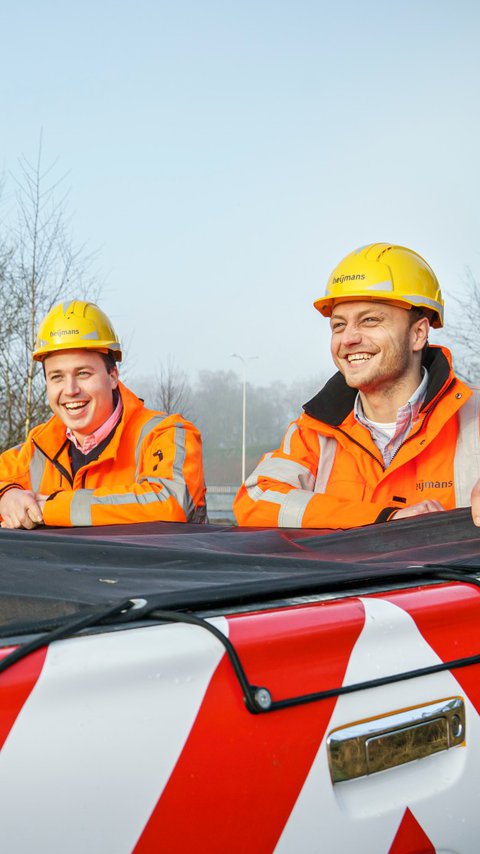A12: an important east-west connection
In 2021, the major maintenance of the A12 motorway was such big news that it made the front pages of the national press. Within the construction team, the Ministry of Public Works and Waterways (Rijkswaterstaat) has expressed its satisfaction with the work. And yet there’s always room for improvement, say Teun Schutte and Gijs van Ommen laconically. These young Heijmans leaders are the very embodiment of modern asset management for infra. “Even if I’m on holiday lying next to the swimming pool, I’m thinking about how to make improvements.”
First of all: there are enough misconceptions about asset management, even at Heijmans, that you could pave the entire A12 with them. For instance, some people see the Infra asset teams as yellow jacks of all trades, who maintain roads, artworks, green areas and service stations, or a wax and polish club. The jokers among us also define asset management as people sitting in folding chairs for prolonged periods so they can spot cracks in artworks on time.
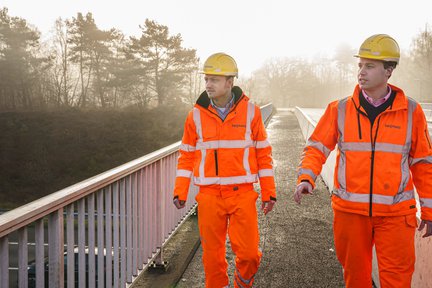
In practice, asset management is considerably more complex. Modern asset management not only requires in-depth technical expertise, but also business insight – especially in terms of risk and costs analyses – plus social, communications and digital skills. Asset managers have to wear a lot of different hats, to be what the Dutch refer to as a five-legged sheep. You’ll find them just outside Bunnik. Not as a curiosity in the meadow, but at a laptop in a big yellow shed. Their names: project manager Teun Schutte (33) and technical manager Gijs van Ommen (31).
Applause
Teun and Gijs are young, smart and keen. They’ve been responsible the execution of the performance contract for the southern section of Central Netherlands (Prestatiecontract Midden Nederland-Zuid - PCMN-Z) since November 2020. That covers the A1, A2, A12, A27 and A28, or a combined 450-kilometre stretch of motorway. Of course, they’re not doing this by themselves: their multidisciplinary team includes a permanent staff of 15 and a variable shell of 30 to 100 workers. Their head office is a spacious shed covered with 55 solar panels, in Bunnik.
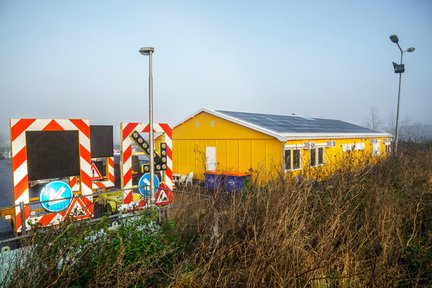
They’ve already received their first round of applause. This is how it all came about: following the freeze and thaw winter of 2020, the Ministry of Public Works and Waterways decided to replace the damaged top layer of the A12 between Woerden and Nieuwerbrug ahead of schedule. Teun: “It was a stretch of 4.5 kilometres. The construction firm proposed closing this stretch of the motorway completely, so they could get more work done and they could guarantee the safety of both road workers and road users more effectively. They wanted to close the road for nine consecutive days, which was brief but pretty heavy”.
The plan was to carry out the work in the summer period, so there would be fewer issues with traffic. After intensive consultations with all kinds of experts in connection with conflicting activities and planned events in this period, the construction team decided to do the work from the end of September to early October.
Trump card
A so-called ‘square closure’ (all lanes closed) is a rarity in the Netherlands, certainly outside the holiday season. “But it is possible”, Gijs says with a smile, “although even our own people needed convincing. Our trump card? Thorough analysis and preparation.” And just as important, of course, was communication with the local municipalities, companies and other parties affected by the closure, Teun stresses. “If you lay everybody’s interests out on the table openly and transparently, you can often do more than you might think.”
Of course the move led to traffic jams and traffic problems, but mainly for drivers in peak hours. This is impossible to prevent with this kind of closure, but it was seen as acceptable when compared with the other alternatives. Or, as one ANWB Traffic service manager described that period in an interview with national daily de Volkskrant: “We received more complaints from Dutch drivers who were stuck in Germany.”
You’re the caretaker of the land, and the ministry’s eyes and ears
With this revolutionary approach to the major maintenance on the A12 motorway, Heijmans has raised the bar for the infra sector to a whole new level. If Teun and Gijs have anything to say about it, the new rule of thumb will be ‘Closed, unless …”. “It’s a lot more efficient and a good deal safer than closing the road for a few nights”, Teun says. And other pros: Heijmans was able to carry out both the long-term maintenance and the life-extending maintenance (Dutch: MJO & LVO) in one fell swoop.
Tilted view
How did they dare to arrive at their radical proposal? Everything is a matter of perception, the two men say. They see asset management differently than traditional construction firms. Teun and Gijs are ambassadors for new ideas, lateral thinking and thinking three steps ahead. They see the area they were set to work in, ‘the land’ in their words, as a testing ground. They are sharing both their successes and the dead ends in their approach with the Asset Management Competence Center (AMCC) in Rosmalen.
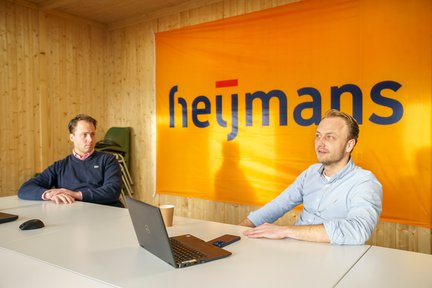
Nor do they spare their own organisation in their findings. That’s because of our drive to improve, Teun explains. “An example? During the major maintenance on the A12, we measured the speed of our own vehicles. That could be better. We can use that insight to help improve safety for all our colleagues.”
Asset management as Teun and Gijs see it is very heavily based on data, which they are constantly gathering and analysing. Their laptop is a treasure trove. With just a few clicks of the mouse in software programme ArcGIS, they can bring up the latest data on countless object types, including more than 11,000 lights, trees, green surfaces, artworks, types of asphalt, damage incidents and their exact positions. All that digital information – the fruits of observations, inspections and maintenance – is the raw material for their advice and actions. In what field? You name it: from the replacement of broken lights and damaged asphalt to repairing damage, cleaning hard shoulders or the maintenance of green areas.
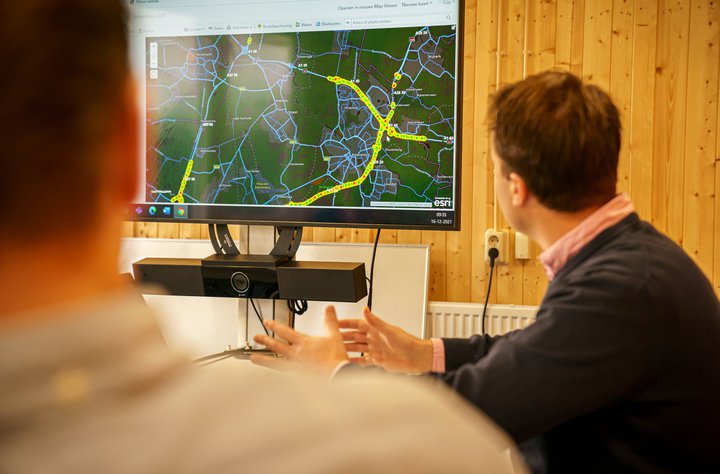
Nature and the environment
Gijs pulls up a digital map of the stretch of the A12 between Oudenrijn and Lunetten on his screen. He points to the numbered red or green dots. They symbolise trees and felling work. “The red examples have ash dieback. That rots their roots, so there’s a danger they could fall.” He pulls up another map: “This is Rijnsweerd. And this green stripe? A 30-year-old oak tree. Take a look: at the inspection on 16 October 2021, that tree was 3.1 metres high and appeared to be completely healthy. But if trees become unstable, we intervene.”
Drawing up an inventory of flora and fauna is a key part of asset management in the 21st Century, Teun adds. “Nature and the environment are becoming more and more important, including the differentiation of control measures. You want to protect the likes of badgers, moor frogs or buzzards. And you need to control the likes of Japanese knotweed and other invasive species.”
The PCMN-Z team also acts as a disaster response organisation. Day and night. “When there’s an accident or an incident, we are on site within 30 minutes”, Gijs says. “We get five or six reports each day, so more than 1,700 reports a year.” These can be very different: from a damaged road surface or guard rail to a tree branch on the road or a lorry with a flat tyre. And it’s not just accidents or (the threat of) traffic accidents they have to deal with. They also have to deal with the likes of vandalism, graffiti or animals hit by cars. “You’re the caretaker of the land”, Teun says, “but also the ministry’s eyes and ears.”
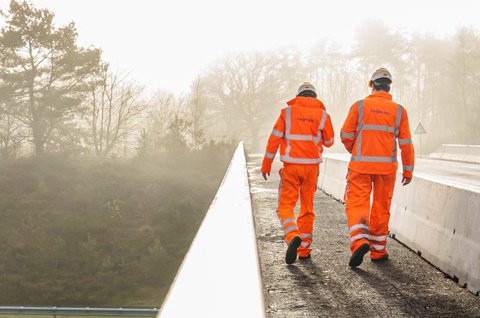
No punishment
The three manned collision shock-absorbers, which can be mobilised at any time of the day, are indispensable for incident management. The PCMN-Z team also has Ford Ranger XLTs on the road, which monitor the entire area every day. Jacco van Eck is one of the drivers. He’s waiting for us on a bridge over the A28 at Soesterberg. Is it his work coat that’s glowing or his pride? Jacco: “Well, it’s certainly not a punishment to drive this truck. Brand new. My colleague Iljan and I also had a say in what truck Heijmans bought. We receive the incident reports digitally. We’ve driven some 13,000 kilometres since September.”
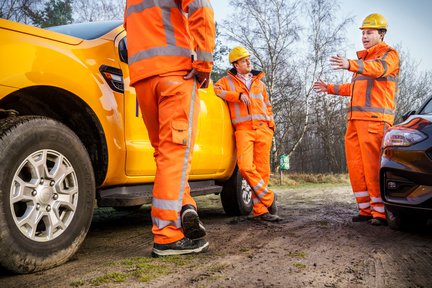
He opens the doors, hatches and the boot. His Ford Ranger appears to be a mobile garage, equipment carrier, first-aid station and camera car – he can take photos and record videos – all in one. The cargo box looks pretty empty on this particular morning. But that’s just a question of patien- Report!
Two loose planks are lying on the hard shoulder of the A28 near the Sterrenweide ecoduct in the direction of Zeist. And Jacco is off. Motto: it’s yellow and constantly in motion. Just like Teun’s and Gijs’s ideas about modern asset management.
